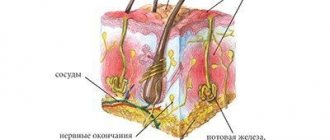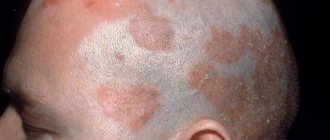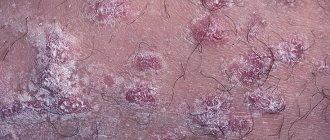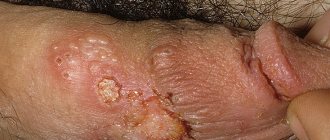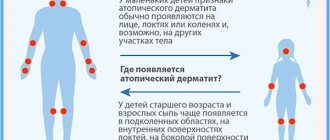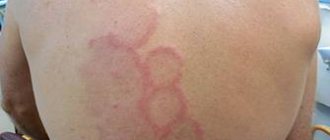It can be difficult even for a doctor to admit the presence of suspicious rashes in the intimate area. However, delay in treatment can lead to a number of serious consequences. Psoriasis in the groin is not life-threatening, but it does cause a lot of discomfort.
This is a disease that affects various areas of the skin. Psoriasis in the groin area is also called inverse, red or intertriginous. The pathology is difficult to treat, but the intimate form is even more difficult.
It is almost impossible to cure completely; it is only possible to stop the development of the disease. Medicine knows of cases where the period of remission lasted a long time: about ten years.
Manifestations of psoriasis in the groin
Psoriasis in the perineum does not develop as often as other forms of this disease; it is considered a rather severe manifestation. Rashes not only appear in the intimate area, they are very itchy, painful, and cause great discomfort.
This disease is provoked due to malfunctions of internal mechanisms. Skin is an organ of the human body that is capable of restoration. She is constantly regenerating. The old outer layer gradually disappears, while a new one is formed underneath it. These processes occur at different speeds in different parts of the body. In the groin of men and women, the skin is especially delicate, soft, and many nerve endings are concentrated here. That is why when a rash occurs, the itching and pain are felt especially acutely.
At a certain point, disturbances occur in the body, due to which the processes of growth of new layers of skin are significantly accelerated. The old scales simply do not have time to fall off before new epidermal cells appear underneath them. Because of this, characteristic bumps appear on the surface, and severe inflammation develops underneath them. The skin becomes inflamed, bright red, and a whitish crust with flaky particles forms on top. They come off quite easily, but underneath they develop abrasions, ulcers and open wounds. This environment is ideal for the development of infections. Psoriasis in its acute form is dangerous due to the occurrence of concomitant diseases.
Description of the disease
The disease itself has been known for a long time. In many works of famous doctors one could find notes about changed skin, red spots covered with skin scales. This suggests that psoriasis existed even in those days when medicine was just beginning to emerge.
The classic clinical picture of psoriasis is:
- On the human body there are areas of skin with lamellar peeling on their surface. All of them gradually merge into huge red plaques with peeling skin in the center.
- The separation of skin flakes is somewhat painful, which causes some inconvenience for patients. After removing a piece of skin, small pinpoint areas of hemorrhage are visible on the surface of the spot (symptom of “blood dew”).
- Each scale has a small spine, due to which it is attached to the skin. These spikes are called the “lady heel” symptom.
- The rash appears predominantly on the extensor surfaces of the skin (the outer side of the shoulder and forearm, the front surface of the legs).
Reasons for development
No one can name the exact reasons for the development of psoriasis in intimate areas in men and women. Malfunctions in the body occur suddenly. This system is too subtle and poorly studied to date. Doctors are constantly conducting research to understand who is predisposed to developing psoriasis, and by what criteria this risk group is formed.
Having received answers to these questions, perhaps experts would find a universal cure for this disease to get rid of it forever. So far, doctors have only achieved success in eliminating the symptoms of psoriasis. Some factors have been identified that provoke an exacerbation of the disease in patients. This list includes:
- Excessive sweating of the body;
- Wearing underwear that is too tight;
- Synthetic underwear;
- Allergic reactions to personal hygiene products;
- Inadequate hygiene;
- Excess weight;
- Long and frequent horseback riding and cycling;
- Passive lifestyle.
If you know what causes complications, you can get rid of the effects of these factors and avoid exacerbations of the disease. Choose underwear made from natural cotton. Men should give up tight swimming trunks, and women should give up thong panties. Use natural hypoallergenic household chemicals for personal hygiene. Some manufacturers produce special gels for intimate hygiene that are suitable for people with psoriasis. If you follow simple rules, you can reduce the likelihood of relapse of the disease and achieve stable long-term remission.
Sex during the acute period of development of the disease must also be excluded. Intimacy will not bring pleasure, but will cause a lot of inconvenience and unpleasant sensations.
Prevention
Preventive measures are aimed at reducing the exacerbation of the disease and increasing periods of remission. To do this, it is necessary to wash the skin with a soft sponge and dry with a soft towel during hygienic bathing. After the water procedure, it is recommended to moisturize the skin with a special cream.
- Do not expose the skin to physical injury in the form of cuts or scratches.
- Avoid the negative effects of chemically active household acids on the skin.
- It is recommended to humidify the air in the room, especially in residential ones, due to the use of air conditioning in the summer.
- Do not neglect personal hygiene measures.
- Beware of diseases that undermine the human body’s immunity.
- Do not abuse alcohol, get rid of bad habits.
Balance your diet by eliminating foods that cause disease.
https://www.youtube.com/watch?v=dQGDb_u4Rxg
Is it possible to confuse psoriasis in the groin with other skin diseases?
Psoriasis in the groin can easily be confused with some sexually transmitted diseases. Some patients are embarrassed to go to the doctor with their problem. They engage in self-diagnosis and self-medication, but such measures, naturally, do not produce results. Over time, when patients are on the verge of despair, they decide to visit a specialist. This should be done immediately after the first symptoms appear. It's easier to get rid of them at an early stage. When the rash grows strongly and occupies an impressive area of the body, it is much more difficult to get rid of it.
A big problem in domestic medicine and pharmacology is that too many drugs are freely available in the pharmacy chain. They can be bought without a prescription. Many of us are accustomed to consulting about certain diseases and their treatment not with a doctor, but with a pharmacist at a pharmacy. But this specialist cannot make diagnoses and prescribe therapy. If you use medications for allergies or certain sexually transmitted diseases against psoriasis, there will be no effect, but side effects will develop.
The first rule of effective treatment of any ailment is that this process should be handled by a doctor. Over time, you will learn to deal with exacerbations on your own, but at that moment the correct diagnosis will already be made. In the meantime, the patient does not know exactly what is happening to him, he should contact a medical facility.
Any skin rashes are treated by a dermatologist. You can immediately make an appointment with this specialist or first visit your family doctor or therapist. Women who are faced with the problem of a rash on the genitals for the first time sometimes first turn to a gynecologist. An experienced doctor will refer you to a dermatologist for further diagnosis.
Diagnostics
Diagnosis of the disease is carried out by a specialist using histological examination of pieces of affected tissue - this allows one to accurately determine the nature of the pathology. In addition, at a dermatologist's appointment, if psoriatic rashes are detected, an additional examination of all parts of the body where there are folds is carried out: intergluteal folds, buttocks and their inner side, armpits, the area under the mammary glands.
Inverse psoriasis is often confused with irritation and diaper rash, dermatitis and sexually transmitted diseases. Therefore, a timely visit to a doctor will allow you to find out the origin of the disease, stop the course and prevent its development on other parts of the body that are susceptible to this particular form of psoriasis.
Treatment methods
In the acute period of development of the disease, treatment of psoriasis in the groin begins with the elimination of annoying symptoms. Hormonal agents for external use will help quickly get rid of pain and itching in the affected area. Corticosteroids are highly effective, but they should not be used frequently or for long periods of time. An additional problem is that when applying it is necessary to ensure that the composition does not get on the mucous membranes. For some time after lubricating the rash, you will have to walk without underwear so that the composition is well absorbed and has time to act.
At the healing stage, the use of antiseptic compounds gives good results. Healing ointments can be used for a long time. Zinc ointment falls into this category. It is inexpensive, but dries out rashes well, eliminates swelling and redness.
Sometimes purulent inflammation occurs against the background of psoriasis. They need special treatment. Effective therapy always includes several topical agents. Some traditional medicines have proven themselves well. Daily baths based on oak bark decoction give excellent results, relieve inflammation and reduce itching.
Psoriasis is well treated with phototherapy. Exposure to ultraviolet rays slows down the regeneration processes of the skin, they are gradually cleansed. When treating psoriasis in the groin, this method is used extremely carefully. The skin here is very delicate and vulnerable. It is rarely exposed to ultraviolet radiation in everyday life. There is a high risk of getting superficial burns.
Such techniques are allowed to be used only on specialized equipment in medical centers under the supervision of experienced medical personnel. During the procedures, the affected areas are covered with special moisturizing compounds, and healthy skin is covered with sunscreen with a high ultraviolet filter. The duration and intensity of the course of treatment is determined individually. It is necessary to undergo it twice a year to achieve a lasting therapeutic effect, remission without relapse.
Forms of psoriatic disease
This or that form of the disease depends on the type of rash and its location. During pregnancy, due to changes in hormonal levels, psoriatic manifestations may disappear or, on the contrary, appear with greater force.
Vulgar psoriasis
The most common form of pathology. The first signs are papular rashes. They can be single, grouped on different parts or throughout the body. As the disease progresses, psoriatic plaques increase in size and gradually merge with each other.
Depending on the form of the rash, ordinary psoriasis is divided into:
- dotted (papules in the form of a dot the size of a match head);
- teardrop-shaped (oblong spots the size of a pinhead);
- coin-shaped (round plaques the size of a pea).
The rashes can have the shape of an arc, a circle, a spiral, or a garland. Sometimes they resemble the outlines of continents on a geographical map. If the disease is localized on the scalp, then they talk about psoriasis of the seborrheic type. Sometimes the neck, nose, forehead, and chest are affected. Diagnosis is difficult due to the similarity of the pathology with seborrhea.
Distinctive features are the clarity of the boundaries of the affected areas, the presence of a “psoriatic triad,” and the silvery color of the scales. There is often itching, and hair does not fall out.
The grouping of plaques on the feet and hands gives the name palmoplantar psoriasis. It is characterized by the formation of polished areas of skin resembling calluses. Psoriasis of nails changes their color, shape and structure. They loosen, become covered with small depressions and take on the appearance of a thimble.
The discharge of exudate from the papules causes a burning sensation. The scales stick together and form a crust that fits tightly to the skin. In this case, they talk about the exudative form of psoriasis.
In severe cases, the entire surface of the body is affected. The skin becomes hot to the touch, acquires a red tint, swells, severe itching, burning and a feeling of tightness appears. This form of the disease is classified as psoriatic erythroderma.
Pustular psoriasis
It is quite rare. It develops against the background of vulgar skin or appears on absolutely healthy skin. In this case, inflamed areas first appear, on which blisters form within 24 hours, quickly turning into pustules. Their contents are sterile and, when leaked, dry out and form crusts.
There are several types of the disease. All of them are characterized by chills, fever, increased body temperature, sometimes diarrhea, and vomiting. The condition worsens when the pustules coalesce and occupy large areas of the skin. If pustular psoriasis occurs against the background of vulgar psoriasis, then fusion is not observed.
Arthropathic psoriasis
It affects joints, most often small ones (phalanxes of the fingers and toes). Sometimes the pathological process affects the spine. This form of psoriasis often leads to disability.
The first signs of the disease are pain that worsens with movement and swelling in the joints. An evening increase in body temperature, disruption of the gastrointestinal tract, and loss of appetite are characteristic of an exacerbation of the disease.
Over time, joint deformation and loss of mobility are observed. The pathology can develop independently or in parallel with the skin manifestations of vulgar psoriasis.
All forms of pathology can develop gradually, over years, or rapidly over several days and even hours. The treatment regimen depends on the form and degree of the disease and should be drawn up by a specialist dermatologist.
Most often, external agents are prescribed in the form of ointments and gels and physiotherapy. In some cases, drug therapy is required. Self-medication can lead to exacerbation of the disease.
Is it possible to have sex with psoriasis?
There is a common misconception among ordinary people that psoriasis is transmitted sexually or through skin-to-skin contact. This disease is completely non-contagious. It is not provoked by viruses or bacteria, which are able to wander from organism to organism. This disease occurs due to malfunctions of the human immune system. Sometimes it is hereditary, but cannot be transmitted to another person during an intimate relationship or everyday communication.
During an exacerbation, you yourself will not be able to have sex, and during the period of remission there are no restrictions. You can lead a full life, but it is advisable to immediately warn your permanent partner about the existing characteristics of the body, so as not to shock him later and prevent the emergence of obviously incorrect speculations. Most sensible people are sympathetic to this problem; there is nothing shameful in psoriasis. This is not a sexually transmitted disease, not an infection.
If you treat your health responsibly, do not self-medicate, and do not practice questionable treatment methods that have no proven effectiveness, then psoriasis in the groin will not cause significant inconvenience.
ICD-10 code
For the convenience of storing information about various diseases, a special reference book was created - the “International Classification of Diseases” (ICD), which contains basic information about each disease with a code attached to it. So, the psoriasis code generally looks like this: L40. But since there are many of its varieties, after the period it is customary to use numbering of the forms of the disease. The inverse type is designated by code L40.8.
Unfortunately, even in times of scientific progress, not all diseases have found the treasured key that helps to understand the essence and nature of pathology. But scientists do not give up, developing more and more new, each time more advanced drugs that can positively influence the course of the disease and slow down its subsequent development. Complex treatment, involving both modern and traditional medicine, is the strongest enemy of any form of psoriasis.
Symptoms
There are two types of groin disease:
- vulgar;
- back.
The development and course of these types has a significant difference. Women note that psoriasis on the pubis and labia in the vulgar form is characterized by the following manifestations:
- pinkish-red rash;
- the surface of the rash is covered with silvery scales;
- excessive peeling.
But with the opposite type, the symptoms will be as follows:
- a profuse rash that forms not on the pubic part, but in the groin area;
- temperature increase. This sign signals the addition of an infection;
- no peeling.
As for men, if vulgar psoriasis develops on the head, a red rash will be observed, affecting not only the head and areas of the foreskin, but also affecting the scrotum. And with the opposite type of pathology, the rash often forms on the folds, is characterized by peeling, and sometimes weeping.
In both cases, patients complain of severe itching and burning on the genitals, in the intimate area and around the anus. Against the background of these symptoms, a person’s health deteriorates.
Manifestations and symptoms in men
Psoriasis in men of an intimate nature is most often located on the genital organ, groin and pubic area. The rash is pinkish-red and slightly raised. Psoriatic spots are hidden by silvery scales. There is no peeling. In some cases, psoriasis on the penis can spread to the internal part of the prepuce.
If psoriasis has formed on a penis of an atypical form, it most often occurs in a severe form. In the groin, smooth spots appear to the touch with the absence of specific scales. the risk is that the affected areas are regularly subjected to mechanical irritation. As a result:
- skin irritation occurs;
- if a disease has formed on the penis, severe itching bothers you;
- the surface of the skin cracks and ulcerates. This condition is dangerous due to infection.
Psoriasis on the glans tends to spread. As a rule, in the absence of timely treatment, the pathology begins to affect more and more new areas of the body.
Therefore, it is important to start treatment immediately
Genital psoriasis is eliminated in a comprehensive manner. Unfortunately, it will not be possible to completely defeat pathology. However, with adequate therapy, you can begin to control the course of the disease. This will help you get rid of negative symptoms.
Manifestations and symptoms in women
Psoriasis appears in intimate places in women more often due to certain factors associated with changes in hormonal levels:
- during puberty;
- while expecting a child;
- with the onset of menopause.
Psoriasis appears on the genitals, pubis, inguinal folds and between the buttocks. In addition, psoriasis forms on the labia. Spots become visible on the mucous membrane, which are often confused with gynecological or infectious manifestations of pathology.
The appearance of psoriasis in women has a specific appearance. Often this is:
- red spots in the form of an oval or circle with clearly visible edges;
- spots covered with grayish scales;
- no itching.
In addition, negative symptoms often form on the vulva and in the anal area. The first symptoms appear in adolescence. This is due to hormonal changes. The next time the pathology may make itself known while you are expecting a child. The next exacerbation occurs already during the onset of menopause.
Sometimes psoriasis in the groin in women is confused with the manifestation of pathologies that are infected through sexual contact. This pushes the fair sex to self-medicate
However, it is important to remember that this is fraught with the development of a number of complications. As a result, treatment is delayed for a long period
Moreover, at the same time, the condition is significantly worsening. For this reason, at the first suspicion of psoriasis on the buttocks, intimate area or anal psoriasis, you should visit a dermatologist.
